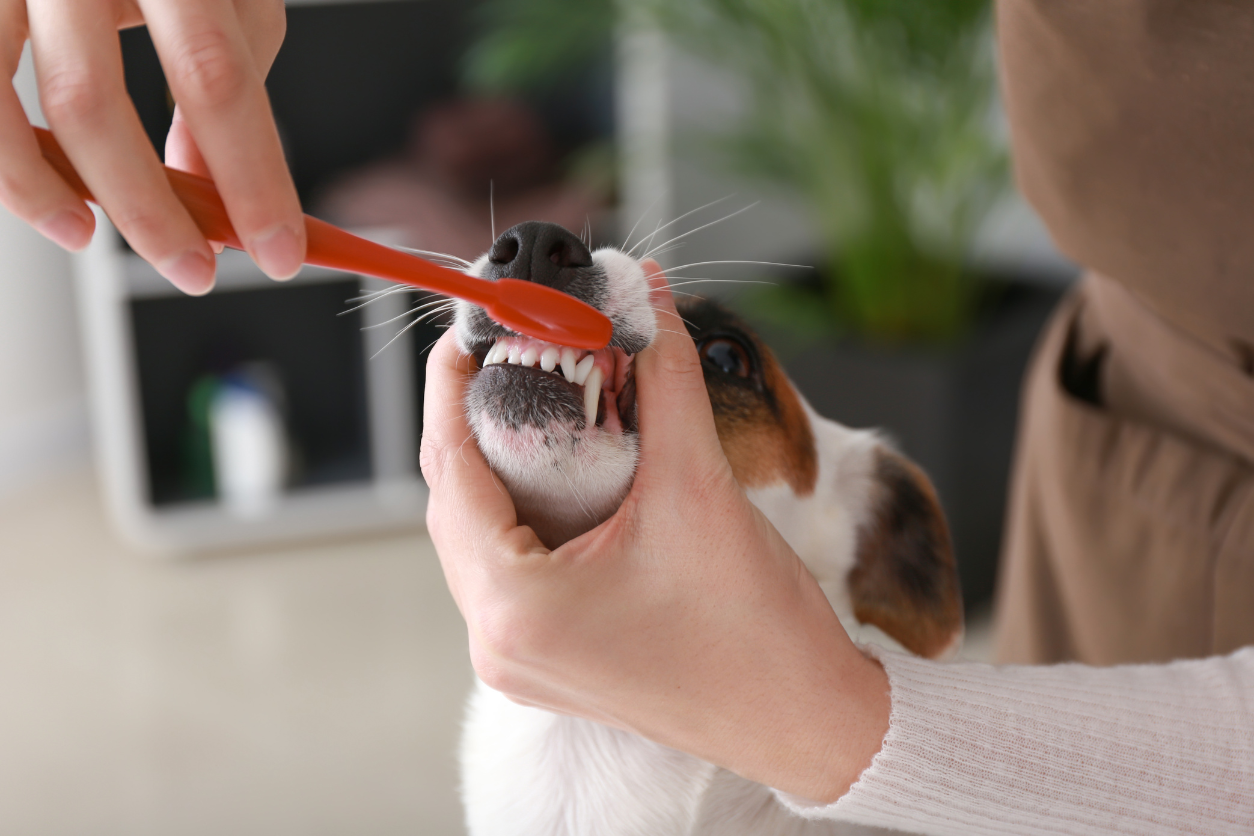Doggie Dental Care: How to Brush a Dog’s Teeth Properly

A healthy smile isn’t just for humans, our furry friends deserve it too! Doggie dental care is a crucial aspect of keeping your canine companion happy and healthy. While many pet owners focus on diet and exercise, oral hygiene often takes a back seat.
In this blog, we’ll dive into the importance of maintaining your dog’s dental health and explore the art of brushing a dog’s teeth properly. From selecting the right tools to overcoming potential challenges, we’ll equip you with the knowledge and tips needed to make dental care an integral part of your pup’s overall well-being.
Why Doggie Dental Care Matters
Just like in humans, poor oral health in dogs can lead to various health issues. Dental problems can cause pain, and bad breath, and even impact your dog’s overall well-being. Moreover, neglected dental care can contribute to more severe conditions that mess with vital organs. Regular dental care not only keeps your dog’s breath fresh but also promotes a healthier, happier life. Making doggie dental care a priority is an investment in your furry friend’s long-term health and vitality.
Selecting the Right Tools
Before diving into the brushing process, gather the right tools. Invest in a dog-specific toothbrush with soft bristles to avoid irritating your pup’s gums. Dog toothpaste is essential, as human toothpaste can be harmful if ingested. Flavored toothpaste, such as poultry or beef, can make the experience more enjoyable for your dog. Additionally, have some toys or dental chews—they act as supplementary aids in maintaining your dog’s dental health.
Introducing Your Dog to Toothbrushing
Introducing toothbrushing gradually is crucial for a positive experience. Start by allowing your dog to sniff and lick the toothbrush and toothpaste. Next, gently rub their teeth and gums with your finger to familiarize them with the sensation. Gradually progress to using the toothbrush, focusing on a few teeth at a time. Reward your dog with praise and treats throughout the process to create positive associations with toothbrushing.
Proper Brushing Technique
When it comes to brushing your dog’s teeth, technique matters. Hold the toothbrush at a 45-degree angle and use small, circular motions. Pay attention to the gumline and back teeth, as these areas are prone to plaque buildup. Be patient and gentle, allowing your dog breaks if needed. Aim for consistency, making toothbrushing a routine part of your dog’s care. The more accustomed they become, the smoother the process will be.
Overcoming Challenges
It’s common for dogs to resist toothbrushing initially. If your pup is resistant, start slow and use positive reinforcement. Gradually increase the duration of each session. If your dog remains uncooperative, consider alternative dental care options such as dental wipes or gels. Consult your veterinarian for guidance on the best approach based on your dog’s personality and specific needs.
Frequency and Monitoring Dental Health
Consistency is key in doggie dental care. Aim to brush your dog’s teeth two to three times per week. Regular monitoring of your dog’s dental health is also crucial. Look out for signs of dental issues such as bad breath, swollen gums, or difficulty eating. If you notice any abnormalities, consult your veterinarian promptly. Additionally, schedule professional dental cleanings as recommended by your vet to address any plaque or tartar buildup that regular brushing may not prevent.
Supplementary Dental Care
In addition to toothbrushing, incorporate toys and dental chews for dogs into your pup’s routine. These items can help reduce plaque and tartar, providing supplementary care between brushings. Look for products approved by veterinary associations to ensure they meet safety and effectiveness standards. Chew toys designed to promote dental health can be an enjoyable way for your dog to contribute to their oral hygiene.
The Role of Diet in Dental Health
A well-balanced diet contributes to overall canine health, including dental well-being. Opt for high-quality dog food that supports dental health, and consider dental-specific diets or additions with proven benefits, such as dental powder or treats. Consult with your veterinarian to determine the most suitable dietary choices for your dog’s unique needs. Proper nutrition not only supports their dental health but also enhances their overall vitality.
Final Note!
Embracing doggie dental care is an essential aspect of responsible pet ownership. By understanding the significance of oral health, selecting the right tools, and employing proper brushing techniques, you can ensure your furry friend enjoys a lifetime of healthy smiles. Patience and positive reinforcement are key in overcoming initial resistance. Remember that dental care extends beyond brushing—incorporate dental chews, toys, and a well-balanced diet into your dog’s routine. With your proactive approach, you’re nurturing a happier, healthier life for your beloved canine companion.
Your Pet’s Best Interest, Always
At Pet Institute, we take pet care seriously. We're dedicated to transparency, impartiality, and the well-being of your pets in every article, review, and recommendation we provide. Our unwavering commitment to these principles ensures that you, our valued reader, always receive reliable and unbiased information. Let us be your trusted guide in the world of pet care and companionship.